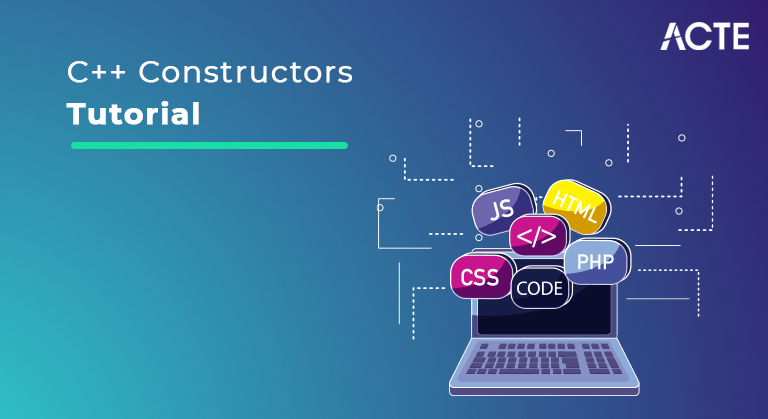
- Introduction to C++ constructor
- How constructors are not the same as an ordinary part work?
- Kinds of Constructors
- Related Topics
- What is a duplicate constructor?
- When is duplicate constructor called?
- When is a client characterized duplicate constructor required?
- What might be the issue assuming that we eliminate duplicate constructor from above code?
- Would we be able to make duplicate constructor private?
- Why contention to a duplicate constructor should be passed as a source of perspective?
- Why contention to a duplicate constructor ought to be const?
- Conclusion of c++ constructor
- Constructor has same name as the actual class
- Constructors don’t have bring type back
- A constructor is naturally called when an item is made.
- It should be put openly part of class.
- In the event that we don’t indicate a constructor, C++ compiler creates a default constructor for object (anticipates no boundaries and has a vacant body).
- // Cpp program to delineate the
- // idea of Constructors
- // CPP program to show
- // defined constructors
- #incorporate <'iostream>
- utilizing namespace sexually transmitted disease;
- Model e = Example(0, 50);//Explicit call
- Model e(0, 50);//Implicit call
- Employments of Defined constructor:
- It is utilized to instate the different information components of various articles with various qualities when they are made.
- It is utilized to over-burden constructors.
- Would we be able to have more than one constructor in a class?
- indeed, It is called Constructor Over-burdening.
- // Delineation
- #incorporate <'iostream>
- utilizing namespace sexually transmitted disease;
- Destructors in C++
- test on constructors in C++
- Result of C++ programs | Set 26 (Constructors)
- Result of C++ programs | Set 27(Constructors and Destructors)
- Kindly record bits of feedback assuming that you find anything erroneous, or you need to share more data about the theme examined previously
- MyClass t1, t2;
- MyClass t3 = t1;// – – – – > (1)
- t2 = t1;// – – – – – > (2)
- #include<'iostream>
- #include<'cstring>
- class String
- {
- private:
- singe *s;
- int size;
- public:
- String(const singe *str = Invalid);//constructor
- ~String() { erase [] s; }//destructor
- void print() { cout << s << endl; }
- void change(const scorch *);//Capacity to change
- };
- String::String(const scorch *str)
- {
- size = strlen(str);
- s = new char[size+1];
- strcpy(s, str);
- }
- void String::change(const scorch *str)
- {
- erase [] s;
- size = strlen(str);
- s = new char[size+1];
- strcpy(s, str);
- }
- int primary()
- {
- String str1(“GeeksQuiz”);
- String str2 = str1;
- str1.print();//what is printed ?
- str2.print();
- str2.change(“GeeksforGeeks”);
- str1.print();//what is printed now ?
- str2.print();
- bring 0 back;
- }
- Output:
Introduction to C++ constructor
A constructor is a unique sort of part capacity of a class which introduces objects of a class. In C++, Constructor is naturally called when object(instance of class) make. It is extraordinary part capacity of the class since it doesn’t have any bring type back.
How constructors are not the same as an ordinary part work?
A constructor is not the same as expected capacities in after ways:
Allow us to comprehend the kinds of constructors in C++ by taking a certifiable model. Assume you went to a shop to purchase a marker. When you need to purchase a marker, what are the choices? The first you go to a shop and say give me a marker. So trying to say give me a marker imply that you didn’t set which brand name and which tone, you referenced nothing say you need a marker.
So when we said just I need a marker so anything the habitually sold marker is there on the lookout or in his shop he will basically give up that. Also this is what a default constructor is! The second technique you go to a shop and say I need a marker a red in shading and XYZ brand. So you are referencing this and he will give you that marker. So for this situation you have given the boundaries.
Furthermore this is what a defined constructor is! Then, at that point, the third one you go to a shop and say I need a marker like this(a actual marker on your hand). So the businessperson will see that marker. OK, and he will give another marker for you. So duplicate of that marker. Also that is the thing duplicate constructor is!
Kinds of Constructors
1. Default Constructors: Default constructor is the constructor which doesn’t take any contention. It has no boundaries.
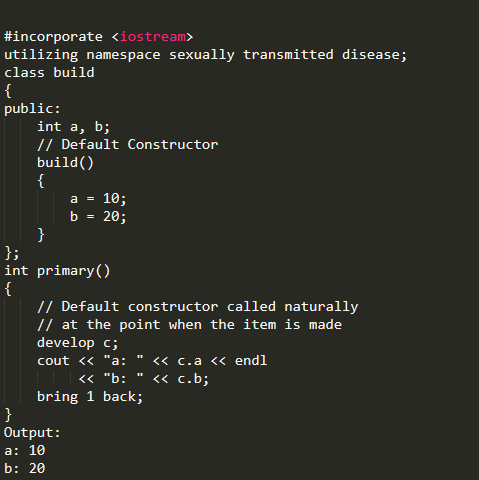
Note: Even in the event that we don’t characterize any constructor unequivocally, the compiler will consequently give a default constructor certainly.
2. Defined Constructors: It is feasible to pass contentions to constructors. Normally, these contentions assist with introducing an article when it is made. To make a defined constructor, basically add boundaries to it the manner in which you would to some other capacity. At the point when you characterize the constructor’s body, utilize the boundaries to introduce the item.
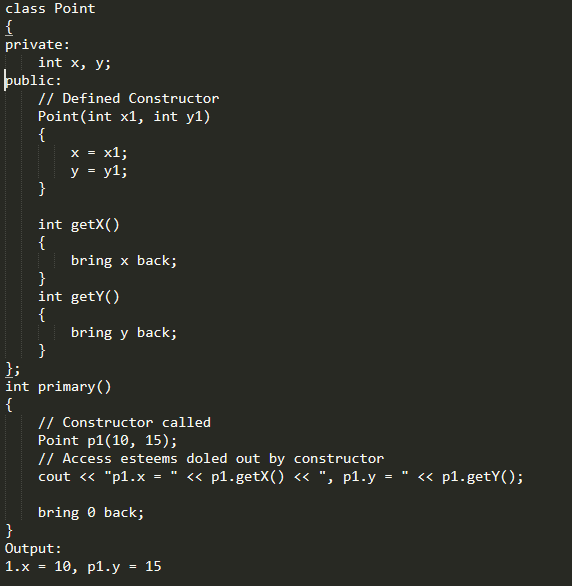
At the point when an article is pronounced in a defined constructor, the underlying qualities must be passed as contentions to the constructor work. The typical method of article announcement may not work. The constructors can be called expressly or verifiably.
3. Duplicate Constructor: A duplicate constructor is a part work which introduces an item utilizing one more object of a similar class. Definite article on Duplicate Constructor.
At whatever point we characterize at least one non-default constructors( with boundaries ) for a class, a default constructor( without boundaries ) ought to likewise be unequivocally characterized as the compiler won’t give a default constructor for this situation. Notwithstanding, it isn’t required yet it’s viewed as the best practice to consistently characterize a default constructor.
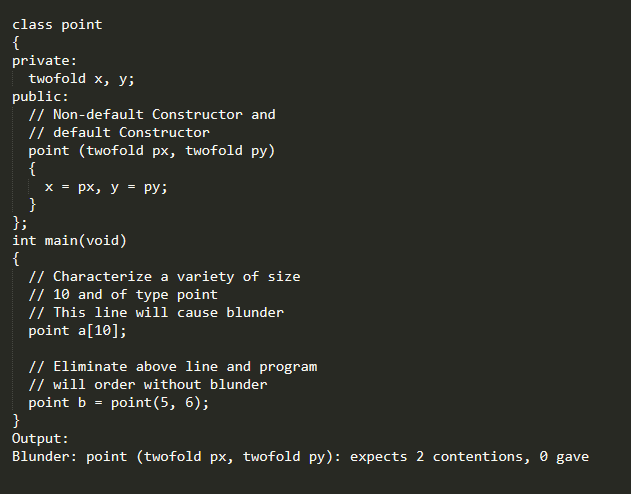
Related Topics:
Need to gain from the best arranged recordings and practice issues, look at the C++ Establishment Course for Essential to Cutting edge C++ and C++ STL Course for establishment in addition to STL. To finish your readiness from learning a language to DS Algo and some more, kindly allude Total Meeting Planning Course. We have examined a prologue to Constructors in C++. Here, the duplicate constructor is examined.
What is a duplicate constructor?
A duplicate constructor is a part work that instates an item utilizing one more object of a similar class. A duplicate constructor has the accompanying general capacity model:
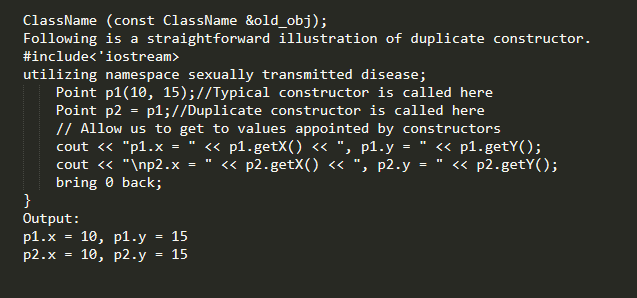
When is duplicate constructor called?
In C++, a Duplicate Constructor might be brought in the accompanying cases:
1. At the point when an object of the class is returned by esteem.
2. At the point when an object of the class is passed (to a capacity) by esteem as a contention.
3. At the point when an article is built in light of one more object of a similar class.
4. At the point when the compiler produces a brief item.
It is, in any case, not ensured that a duplicate constructor will be brought in this multitude of cases, on the grounds that the C++ Standard permits the compiler to improve the duplicate away in specific cases, one model is the return esteem streamlining (now and again alluded to as RVO).
When is a client characterized duplicate constructor required?
On the off chance that we don’t characterize our own duplicate constructor, the C++ compiler makes a default duplicate constructor for each class which does a part insightful duplicate between objects. The compiler made duplicate constructor turns out great overall. We want to characterize our own duplicate constructor provided that an item has pointers or any runtime assignment of the asset like filehandle, an organization connection..etc. The default constructor truly does just shallow duplicate.
shallow
Profound duplicate is conceivable just with client characterized duplicate constructor. In client characterized duplicate constructor, we ensure that pointers (or references) of replicated object highlight new memory areas.
Which of the accompanying two assertions call duplicate constructor and which one calls task administrator?
Duplicate constructor is called when another item is made from a current article, as a duplicate of the current article. Task administrator is called when an all around instated object is doled out another worth from another current item. In the above model (1) calls duplicate constructor and (2) calls task administrator. See this for additional subtleties.
Compose a model class where duplicate constructor is required?
Following is a finished C++ program to show utilization of Duplicate constructor. In the accompanying String class, we should compose duplicate constructor.
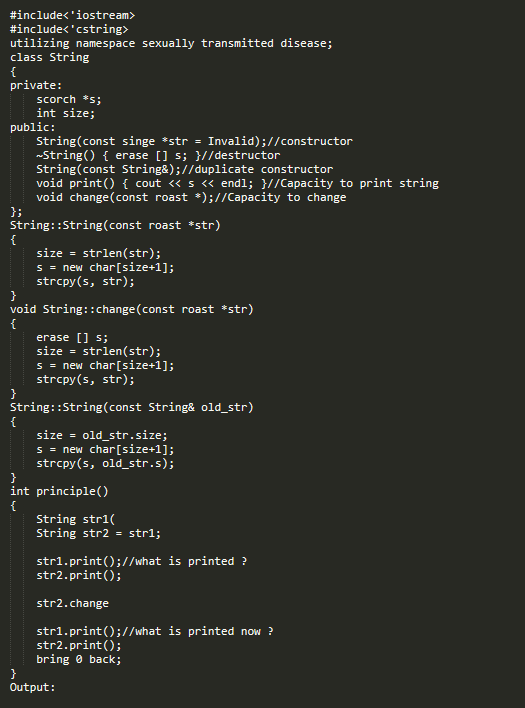
What might be the issue assuming that we eliminate duplicate constructor from above code?
Assuming we eliminate duplicate constructor from the above program, we don’t get the normal result. The progressions made to str2 reflect in str1 also which is rarely anticipated.
Would we be able to make duplicate constructor private?
Indeed, a duplicate constructor can be made private. At the point when we make a duplicate constructor private in a class, objects of that class become non-copyable. This is especially valuable when our class has pointers or powerfully dispensed assets. In such circumstances, we can either compose our own duplicate constructor like above String model or make a private duplicate constructor with the goal that clients get compiler blunders rather than shocks at runtime.
Why contention to a duplicate constructor should be passed as a source of perspective?
A duplicate constructor is called when an article is passed by esteem. Duplicate constructor itself is a capacity. So in the event that we pass a contention by esteem in a duplicate constructor, a call to duplicate constructor would be settled on to decision duplicate constructor which turns into a non-ending chain of calls. Thusly compiler doesn’t permit boundaries to be passed by esteem.
Why contention to a duplicate constructor ought to be const?
Kindly record remark in the event that you find anything inaccurate, or you need to share more data about the point examined previously. Need to gain from the best organized recordings and practice issues, look at the C++ Establishment Course for Essential to Cutting edge C++ and C++ STL Course for establishment in addition to STL. To finish your planning from learning a language to DS Algo and some more, kindly allude Total Meeting Arrangement Course.
Conclusion of c++ constructor:
The constructor might be characterized as the exceptional component of the programming dialects which is utilized to make the program compelling and effective. It can likewise be considered as an extraordinary kind of technique that has the very name as that of the class and can be conjured at whatever point the object of that class is made.






